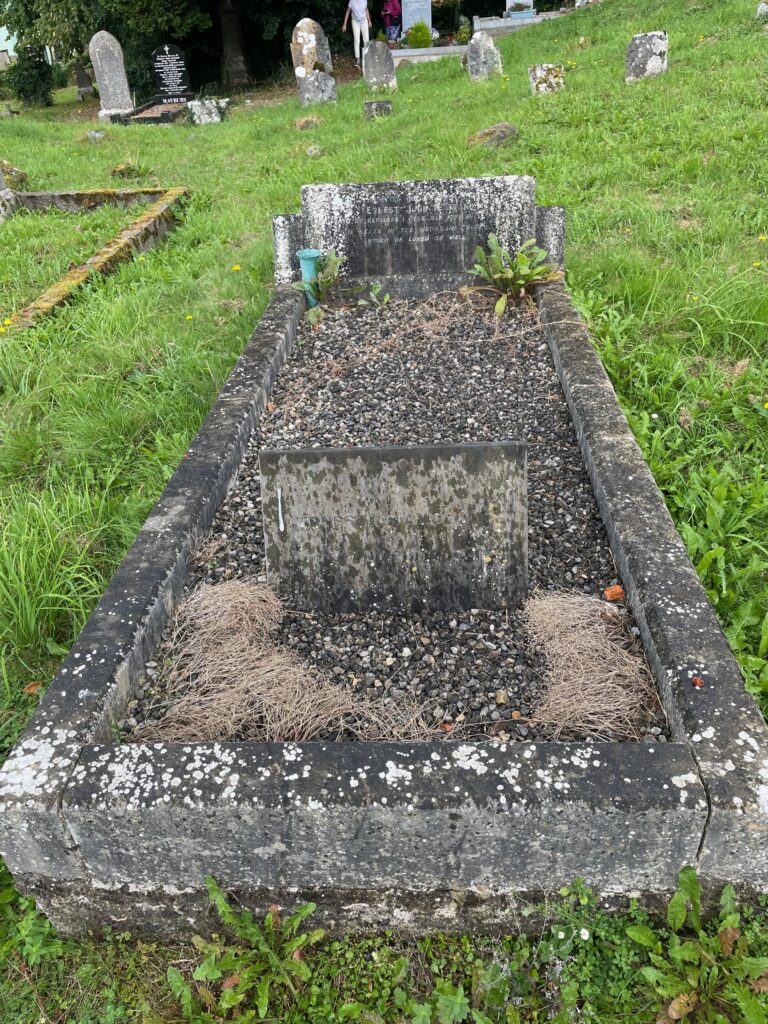Erik Visits an (Non) American Grave, Part 1,571
This is the grave of Ernest John Moeran.

Born in Heston, Middlsex, England in 1894, Moeran grew up well-off, the son of a prominent minister. His mother was a pianist and taught her young son how to play. He proved very good and his parents sent him to some of the nation’s finest music schools. He learned the violin as well, to the point where he could play in a string quartet. He started at the Royal College of Music in 1913. He was also accepted into the Oxford and Cambridge Musical Club, which was big deal and where he got to hob nob with such established people as Vaughn Williams and Adrian Boult.
Moeran’s education was interrupted by World War I. He enlisted almost immediately and was a dispatch rider on motorcycles and was commissioned as a second lieutenant. He finally got injured in May 1917, during the Second Battle of Bullecourt. He took a shot to the head. He survived, but needed a metal plate in his head, and his personal behavior became pretty rough after this brain injury. After he recovered, he was transferred to less dangerous duty in Ireland. He also started collecting Irish folk tunes while there, part of his life long love of folk music.
After the war, Moeran was discharged. Since the family was wealthy, he didn’t have to work. So he spent all his time on his music while his mother especially supported him financially. While he didn’t exactly become a major composer during these years, he certainly became a good enough and respected composer, publishing and performing many of his own works. He became drinking buddies with his fellow composer Philip Heseltine. They moved in together and basically had a bachelor pad filled with enormous drinking parties of the nation’s cultural elite. Unfortunately, drinking would come to dominate Moeran’s life, at least as much as composing. He basically dropped out of working between 1925 and 1928, just as he had made a name for himself. He mostly just committed himself to the bottle.
Moeran bottomed out in 1929 and then Heseltine killed himself during a drunken binge in 1930. His parents went and got him. Music critics returned to his earlier works and talked of how much they wanted to hear some new material. While convalescing from the booze and an accident of some kind, he began to work again. Sonata for Two Violins was completed in 1930. Then came String Trio, Wythorne’s Shadow, and Lonely Waters by 1932. Still deeply influenced by various forms of British folk music, these works attempted to merge the British vernacular tradition in his high-end music, a bit like Aaron Copland in the U.S. Probably his most respected work in Symphony in G Minor, from 1937, which many music critics consider to be perhaps the best British symphony published in the interwar years.
By the late 30s, Moeran started spending more time in Ireland, where his family had originally established itself. He moved to the town of Kenmare, in County Kerry and lived in a cottage there. He still worked pretty consistently through the decade, but the heavy drinking returned too. He had to serve nine months of some kind of medical confinement after being caught drunk driving while in Cambridge. He continued working though through these years, including several of his most important works. He married for awhile in 1945, but it was to another ambitious musician, a cellist named Peers Coetmore. She was on the road a lot and the marriage didn’t really take.
Finally in 1950, after yet more heavy drinking, Moeran threw himself off the Kenmare pier. Or maybe it was a cerebral hemorrhage while he was walking and then he fell off; there is some debate over this. In any case, he was 55 years old.
Overall, Moeran is a minor composer in the history of classical music. But a minor composer for something as long as the history of classical music is still something very much worth remembering. His works are still performed today on and off.
Let’s hear some of Moeran’s works:
Ernest John Moeran is buried in Killowen Burial Grounds, Kenmare, County Kerry, Ireland.
If you would like this series to visit some American composers, you can donate to cover the required expenses here. Aaron Copland is at the Tanglewood Music Center in the Berkshires. Samuel Barber is in West Goshen, Pennsylvania. Previous posts in this series are archived here and here.


